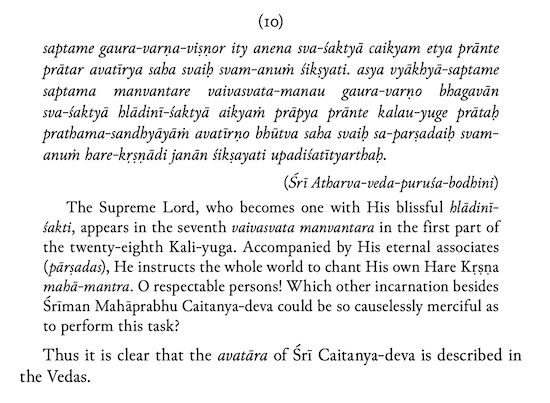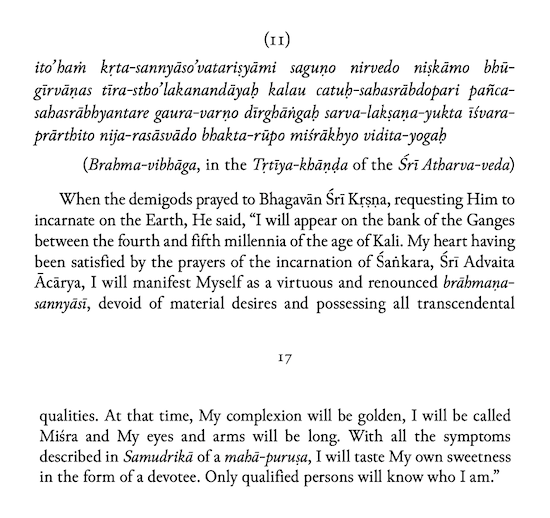Caitanya Mahaprabhu — Scriptural Proofs of His Avatarahood and Divinity. Part 3
 All that has been said about the Caitanya-upaniṣad applies equally to the Gopāla-tāpanī-upaniṣad, the Kṛṣṇa-upaniṣad and the Puruṣa-bodhini-upaniṣad (Puruṣa-bodhini-śruti), passages from which Caitanya’s followers quote as prophecies of Caitanya’s appearance. The style of these works is not similar to that of the well-known authoritative ancient Upaniṣads. Śaṅkara, Rāmānuja, Madhva and their followers (pre-Caitanya and post-Caitanya periods) do not quote, refer, mention or comment on these Upaniṣads. No evidence of the existence of a tradition (śākhā) of custodians of these Upaniṣads in ancient times has been found. Nor has their existence been discovered today. The above Upaniṣads are declared to be parts of the Atharvaveda, but the Atharvavedins claim that these historical sources have nothing to do with the Atharvaveda.
In 2015 in Udupi, I consulted with Śatāvadhānī Uḍupi Rāmanātha Ācārya, a paṇḍita and teacher of the Ṛgveda and Atharvaveda. He alleges that these passages have nothing to do with the Atharvaveda and Sāmaveda.
All that has been said about the Caitanya-upaniṣad applies equally to the Gopāla-tāpanī-upaniṣad, the Kṛṣṇa-upaniṣad and the Puruṣa-bodhini-upaniṣad (Puruṣa-bodhini-śruti), passages from which Caitanya’s followers quote as prophecies of Caitanya’s appearance. The style of these works is not similar to that of the well-known authoritative ancient Upaniṣads. Śaṅkara, Rāmānuja, Madhva and their followers (pre-Caitanya and post-Caitanya periods) do not quote, refer, mention or comment on these Upaniṣads. No evidence of the existence of a tradition (śākhā) of custodians of these Upaniṣads in ancient times has been found. Nor has their existence been discovered today. The above Upaniṣads are declared to be parts of the Atharvaveda, but the Atharvavedins claim that these historical sources have nothing to do with the Atharvaveda.
In 2015 in Udupi, I consulted with Śatāvadhānī Uḍupi Rāmanātha Ācārya, a paṇḍita and teacher of the Ṛgveda and Atharvaveda. He alleges that these passages have nothing to do with the Atharvaveda and Sāmaveda.
 The passage is from an unknown source, but it is definitely not Vedic, neither by the title of the sections nor by the language of presentation. Śatāvadhānī Uḍupi Rāmanātha Ācārya highlights strange types of sections, which are absent in the Atharvaveda: “3rd kh., Brahma-vibhāga” Probably kh. means khāṇḍa. There are 40 kāṇḍa-s instead of khāṇḍa-s in the Atharvaveda. Even if khāṇḍa is a clerical error, still, the passage offered by Nārāyaṇa Mahārāja is absent in the third kāṇḍa of the Atharvaveda. The Atharvaveda does not have sections named vibhāga, so there is not section named Brahma-vibhāga either.
In the passage we see a typical biographical scheme: Caitanya’s acceptance of monasticism–the place of his birth–the time of his appearance–the golden colour. In the proofs the scheme varies, key milestones of the biography are simply rearranged.
If the passage were really from the Atharvaveda, it could rightly be considered the oldest and earliest proof of Caitanya’s divinity, but the founders of the tradition — Rūpa, Sanātana, Jīva, Viśvanātha and Baladeva — do not mention or quote it in their works. The passage is completely devoid of Vedic accents. There is not a single linguistic feature, not a single verb form, not a single morphological feature typical of the style of the Vedas. The passage does not recognise Vedic metre, or rather, does not recognise any metre at all. Nor does it contain specific Vedic elements, such as the injunctive or conjunctive. In no Gauḍīya work before the nineteenth century does this passage appear.
The word nirvedo (“renunciation”) is missing from Nārāyaṇa Mahārāja’s translation. The word nirvedo itself is a noun. Grammar and dictionary meanings exclude the meaning of “renounced” (“brāhmaṇa-sannyāsī”), but there is the indefinite but typical ISKCON lexicon stamp “free from material desires”, referring to the word niṣkāmo. The word simply means “free from desire (or attraction)”, “indifferent”, “selfless”, “unselfish”.
The words “I will appear on the bank of the Ganges between the fourth and fifth millennia of the age of Kali” are an improved version of the “original” in which complete nonsense is written:
The passage is from an unknown source, but it is definitely not Vedic, neither by the title of the sections nor by the language of presentation. Śatāvadhānī Uḍupi Rāmanātha Ācārya highlights strange types of sections, which are absent in the Atharvaveda: “3rd kh., Brahma-vibhāga” Probably kh. means khāṇḍa. There are 40 kāṇḍa-s instead of khāṇḍa-s in the Atharvaveda. Even if khāṇḍa is a clerical error, still, the passage offered by Nārāyaṇa Mahārāja is absent in the third kāṇḍa of the Atharvaveda. The Atharvaveda does not have sections named vibhāga, so there is not section named Brahma-vibhāga either.
In the passage we see a typical biographical scheme: Caitanya’s acceptance of monasticism–the place of his birth–the time of his appearance–the golden colour. In the proofs the scheme varies, key milestones of the biography are simply rearranged.
If the passage were really from the Atharvaveda, it could rightly be considered the oldest and earliest proof of Caitanya’s divinity, but the founders of the tradition — Rūpa, Sanātana, Jīva, Viśvanātha and Baladeva — do not mention or quote it in their works. The passage is completely devoid of Vedic accents. There is not a single linguistic feature, not a single verb form, not a single morphological feature typical of the style of the Vedas. The passage does not recognise Vedic metre, or rather, does not recognise any metre at all. Nor does it contain specific Vedic elements, such as the injunctive or conjunctive. In no Gauḍīya work before the nineteenth century does this passage appear.
The word nirvedo (“renunciation”) is missing from Nārāyaṇa Mahārāja’s translation. The word nirvedo itself is a noun. Grammar and dictionary meanings exclude the meaning of “renounced” (“brāhmaṇa-sannyāsī”), but there is the indefinite but typical ISKCON lexicon stamp “free from material desires”, referring to the word niṣkāmo. The word simply means “free from desire (or attraction)”, “indifferent”, “selfless”, “unselfish”.
The words “I will appear on the bank of the Ganges between the fourth and fifth millennia of the age of Kali” are an improved version of the “original” in which complete nonsense is written:

